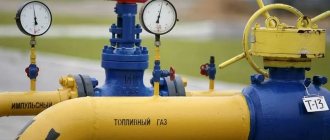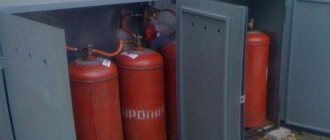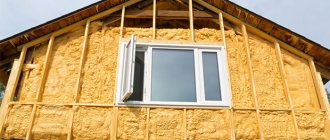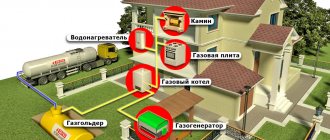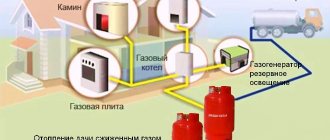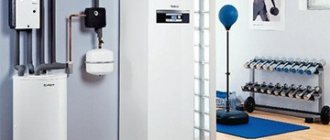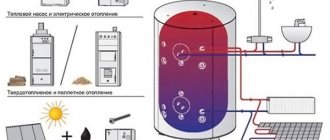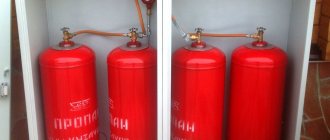When designing a heating system for a home, owners are required to know in advance how much it will cost to heat their living space during operation. Ultimately, it may be that the heating system will simply be unprofitable if the equipment is chosen incorrectly, the design is poorly designed, or the walls are poorly insulated. Therefore, it is important to correctly calculate the gas consumption for heating a house of 200 m2. From the obtained figure you can already start and start or not start designing and purchasing equipment.
What determines gas consumption in gas heating boilers?
The first criterion for choosing any heating device is power.
That is, how much area a boiler or other device is able to heat. Next, the user evaluates the efficiency, i.e. what financial costs will be needed for this.
Costs depend primarily on the type of fuel. Gas boilers are considered the most economical heating devices in Russia. What determines gas consumption in gas heating boilers?
How to calculate consumption
The characteristics of the device indicate two figures: maximum consumption of liquefied gas and main gas. The consumption of liquefied gas in gas heating boilers is expressed in kilograms per hour, main gas - in cubic meters per hour.
Multiplying the figure by 24 hours and 30 days we get the monthly consumption. We multiply it by the tariff rate in your region, and you get the amount that you will have to spend on heating per month. In fact, the boiler operates at full capacity only half of this time, i.e. the resulting amount must be divided by two.
For liquefied gas, we divide the monthly consumption in half, then by the amount of gas in the cylinder (about 21 kg), we get the number of cylinders and multiply by the price of refilling.
For double-circuit boilers, you need to add 25 percent to the obtained value (about heating schemes for a private house with a gas boiler).
Additional factors
There is a direct connection between the power of the unit and fuel consumption. When choosing a boiler, a certain power reserve is included, but in general this characteristic should be correlated with the dimensions of the house.
In temperate climate zones, heating 10 square meters of area requires 1 kilowatt of energy. Those. for a house 100 meters away, a 12 kW boiler is enough; there is no need to purchase a powerful 60 kW (about the operating principle of a gas heating boiler).
Circumstances that affect the amount of fuel consumed:
- gas quality;
- outside temperature during the heating season;
- thermal insulation of the house;
- working condition of the chimney and other elements of the system;
- design features of heating circuits;
- type of boiler.
All these factors, with the exception of the quality of the supplied main gas, depend on you. The more thoroughly the thermal insulation of the premises is carried out, the lower the heat loss; The higher the efficiency of the system, the lower the energy consumption for heating.
Chimneys need to be cleaned regularly, and other equipment must be monitored for serviceability.
The choice of heating unit is made based on the totality of all its features.
For example:
- the use of energy-dependent automation will reduce fuel consumption and facilitate operation (types of automation for gas heating boilers). But with it there will be additional cash costs for electricity;
- boilers with closed fireboxes are more economical than open ones, but they are more expensive and more difficult to install;
- The most economical boiler is a condensing boiler. Efficiency is up to 98%, while a simple convection unit has 92-94. But condensing models have the highest price and have a certain temperature limit;
- An effective way to reduce burner operating time (types of gas burners for heating boilers) is to purchase a heat accumulator or install a boiler. But to maintain the desired temperature in the tank, more fuel will be required.
Liquefied and main gas
The consumption of liquefied gas in gas heating boilers is usually higher than that of main gas, and the final cost of such heating is higher.
But, firstly, it is not possible to connect to the main line everywhere, and secondly, material costs will still be low compared to other types of boilers, especially electric ones.
In conclusion, it should be remembered that in the heating system there is most often a component that operates from the electrical network: a pump.
Video about how to reduce boiler gas consumption.
https://youtube.com/watch?v=ADrS6_gE4co
Warm floor or conventional radiators
Also, the correct heating design plays an important role. It is estimated that a well-designed and implemented heated floor will reduce gas consumption. Conventional radiators would require more gas to heat indoor air to the same level. This is due to the fact that thanks to a warm floor, heat rises from bottom to top and spreads throughout the entire area of the room. But conventional batteries heat the outer wall, which is why their efficiency is lower.
Also, the standard floor temperature is 50 degrees, the radiator is 90 degrees. Obviously, the floors will be more efficient and economical. Yes, the project and installation of flooring will cost more, but the difference in price will pay off very quickly.
Calculation of gas consumption
Knowing the total heat loss, you can quite simply calculate the required consumption of natural or liquefied gas for heating a house with an area of 200 m2.
The amount of energy released, in addition to the volume of fuel, is affected by its calorific value. For gas, this indicator depends on the humidity and chemical composition of the supplied mixture. There are higher (Hh) and lower (Hl) calorific values.
The lower calorific value of propane is less than that of butane. Therefore, in order to accurately determine the calorific value of liquefied gas, you need to know the percentage of these components in the mixture supplied to the boiler
To calculate the volume of fuel that is guaranteed to be enough for heating, the value of the lower calorific value, which can be obtained from the gas supplier, is substituted into the formula. The standard unit for measuring calorific value is “mJ/m3” or “mJ/kg”. But since the units of measurement of both boiler power and heat loss operate with watts, not joules, it is necessary to perform a conversion, taking into account that 1 mJ = 278 W × h.
If the value of the lower calorific value of the mixture is unknown, then it is permissible to take the following averaged figures:
- for natural gas Hl = 9.3 kW × h / m3;
- for liquefied gas Hl = 12.6 kW × h / kg.
Another indicator required for calculations is boiler efficiency K. It is usually measured as a percentage. The final formula for gas consumption over a period of time E (h) is as follows:
V = Q × E / (Hl × K / 100).
The period when centralized heating is turned on in houses is determined by the average daily air temperature.
If over the last five days it does not exceed “+ 8 °C”, then according to Decree of the Government of the Russian Federation No. 307 of May 13, 2006, heat supply to the house must be ensured. For private houses with autonomous heating, these figures are also used when calculating fuel consumption.
Exact data on the number of days with a temperature not higher than “+ 8 ° C” for the area where the cottage was built can be found in the local branch of the Hydrometeorological Center.
If the house is located close to a large populated area, then it is easier to use the table. 1. SNiP 23-01-99 (column No. 11). Multiplying this value by 24 (hours per day) we obtain parameter E from the equation for calculating gas flow.
According to climatic data from table. 1 SNiP 23-01-99 construction organizations carry out calculations to determine the heat loss of buildings
If the volume of air inflow and the temperature inside the premises are constant (or with minor fluctuations), then heat loss both through the building envelope and due to ventilation of the premises will be directly proportional to the outside air temperature.
Therefore, for parameter T2 in the equations for calculating heat loss, you can take the value from column No. 12 of the table. 1. SNiP 23-01-99.
Finding the amount of energy loss
In order to determine the amount of energy that a house loses, it is necessary to know the climatic characteristics of the area, the thermal conductivity of materials and ventilation standards. And to calculate the required volume of gas, it is enough to know its calorific value. The most important thing in this work is attention to detail.
Heating a building must compensate for heat losses that occur for two main reasons: heat leakage around the perimeter of the house and the influx of cold air through the ventilation system. Both of these processes are described by mathematical formulas, which you can use to carry out your own calculations.
Thermal conductivity and thermal resistance of the material
Any material can conduct heat. The intensity of its transmission is expressed by the thermal conductivity coefficient λ (W / (m × °C)). The lower it is, the better the structure is protected from freezing in winter.
Heating costs depend on the thermal conductivity of the material from which the house will be built. This is especially important for the “cold” regions of the country
However, buildings can be stacked or insulated with material of varying thicknesses. Therefore, in practical calculations, the heat transfer resistance coefficient is used:
R (m2 × °C / W)
It is related to thermal conductivity by the following formula:
R = h/λ,
where h is the thickness of the material (m).
Example. Let's determine the heat transfer resistance coefficient of aerated concrete blocks of grade D700 of different widths at λ = 0.16:
- width 300 mm: R = 0.3 / 0.16 = 1.88;
- width 400 mm: R = 0.4 / 0.16 = 2.50.
For insulating materials and window blocks, both the thermal conductivity coefficient and the heat transfer resistance coefficient can be given.
If the enclosing structure consists of several materials, then when determining the heat transfer resistance coefficient of the entire “pie,” the coefficients of its individual layers are summed up.
Example. The wall is built from aerated concrete blocks (λb = 0.16), 300 mm thick. From the outside it is insulated with extruded polystyrene foam (λp = 0.03) 50 mm thick, and from the inside it is lined with clapboard (λv = 0.18), 20 mm thick.
There are tables for various regions that indicate the minimum values of the total heat transfer coefficient for the perimeter of the house. They are advisory in nature
Now you can calculate the total heat transfer resistance coefficient:
R = 0.3 / 0.16 + 0.05 / 0.03 + 0.02 / 0.18 = 1.88 + 1.66 + 0.11 = 3.65.
The contribution of layers that are insignificant in terms of the “heat saving” parameter can be neglected.
Calculation of heat loss through building envelopes
Heat loss Q (W) through a homogeneous surface can be calculated as follows:
Q = S × dT / R,
Where:
- S – area of the surface under consideration (m2);
- dT – temperature difference between the air inside and outside the room (°C);
- R – coefficient of resistance to heat transfer of the surface (m2 * °C / W).
To determine the total indicator of all heat losses, perform the following steps:
- select areas that are homogeneous in terms of heat transfer resistance coefficient;
- calculate their areas;
- determine thermal resistance indicators;
- calculate heat loss for each section;
- summarize the obtained values.
Example. Corner room 3 × 4 meters on the top floor with a cold attic space. The final ceiling height is 2.7 meters. There are 2 windows, measuring 1 × 1.5 m.
Let’s find the heat loss through the perimeter at an air temperature inside “+25 °С”, and outside – “–15 °С”:
- Let us select areas that are homogeneous in terms of resistance coefficient: ceiling, wall, windows.
- Ceiling area Sp = 3 × 4 = 12 m2. Window area So = 2 × (1 × 1.5) = 3 m2. Wall area Sc = (3 + 4) × 2.7 – So = 29.4 m2.
- The coefficient of thermal resistance of the ceiling is composed of the ceiling (board 0.025 m thick), insulation (mineral wool slabs 0.10 m thick) and the wooden floor of the attic (wood and plywood with a total thickness of 0.05 m): Rп = 0.025 / 0.18 + 0.1 / 0.037 + 0.05 / 0.18 = 3.12. For windows, the value is taken from the passport of a double-glazed window: Ro = 0.50. For a wall built as in the previous example: Rс = 3.65.
- Qp = 12 × 40 / 3.12 = 154 W. Qо = 3 × 40 / 0.50 = 240 W. Qс = 29.4 × 40 / 3.65 = 322 W.
- The total heat loss of the model room through the enclosing structures is Q = Qп + Qо + Qс = 716 W.
Calculation using the above formulas gives a good approximation, provided that the material meets the declared thermal conductivity qualities and there are no errors that could be made during construction. The problem may also be the aging of materials and the structure of the house as a whole.
Typical wall and roof geometry
When determining heat loss, it is customary to take the linear parameters (length and height) of a structure internal rather than external. That is, when calculating heat transfer through a material, the contact area of warm rather than cold air is taken into account.
When calculating the internal perimeter, it is necessary to take into account the thickness of the interior partitions. The easiest way to do this is using a house plan, which is usually drawn on paper with a scale grid.
Thus, for example, with house dimensions of 8 × 10 meters and a wall thickness of 0.3 meters, the internal perimeter Pin = (9.4 + 7.4) × 2 = 33.6 m, and the external perimeter Pex = (8 + 10) × 2 = 36 m.
The interfloor ceiling usually has a thickness of 0.20 to 0.30 m. Therefore, the height of the two floors from the floor of the first to the ceiling of the second from the outside will be equal to Hexternal = 2.7 + 0.2 + 2.7 = 5.6 m. If you add up only the final height, you will get a smaller value: Hinternal = 2.7 + 2.7 = 5.4 m. The interfloor ceiling, unlike the walls, does not serve as insulation, so for calculations you need to take Hext.
For two-story houses with dimensions of about 200 m2, the difference between the area of the walls inside and outside is from 6 to 9%. Similarly, the internal dimensions take into account the geometric parameters of the roof and ceilings.
Calculating the wall area for cottages with simple geometry is elementary, since the fragments consist of rectangular sections and gables of attic and attic spaces.
The gables of attics and attics in most cases have the shape of a triangle or a vertically symmetrical pentagon. Calculating their area is quite simple
When calculating heat loss through a roof, in most cases it is enough to apply formulas for finding the areas of a triangle, rectangle and trapezoid.
The most popular forms of roofs of private houses. When measuring their parameters, you need to remember that internal dimensions are included in the calculations (without eaves overhangs)
The area of the laid roof cannot be taken into account when determining heat loss, since it also goes to the overhangs, which are not taken into account in the formula. In addition, often the material (for example, roofing felt or profiled galvanized sheet) is placed with a slight overlap.
Sometimes it seems that calculating the roof area is quite difficult. However, inside the house the geometry of the insulated fencing of the upper floor can be much simpler
The rectangular geometry of the windows also does not cause problems in calculations. If the double-glazed windows have a complex shape, then their area can not be calculated, but can be found out from the product passport.
Heat loss through the floor and foundation
Calculation of heat loss into the ground through the floor of the lower floor, as well as through the walls and floor of the basement, is calculated according to the rules prescribed in Appendix “E” of SP 50.13330.2012. The fact is that the speed of heat propagation in the ground is much lower than in the atmosphere, so soils can also be conditionally classified as insulating materials.
But since they tend to freeze, the floor area is divided into 4 zones. The width of the first three is 2 meters, and the fourth includes the remaining part.
The heat loss zones of the floor and basement follow the shape of the foundation perimeter. The main heat loss will go through zone No. 1
For each zone, the heat transfer resistance coefficient added by the soil is determined:
- zone 1: R1 = 2.1;
- zone 2: R2 = 4.3;
- zone 3: R3 = 8.6;
- zone 4: R4 = 14.2.
If the floors are insulated, then to determine the overall coefficient of thermal resistance, the insulation and soil indicators are added.
Example. Let a house with external dimensions of 10 × 8 m and a wall thickness of 0.3 meters have a basement with a depth of 2.7 meters. Its ceiling is located at ground level. It is necessary to calculate heat loss into the ground at an internal air temperature of “+25 °C”, and an external air temperature of “-15 °C”.
Let the walls be made of FBS blocks, 40 cm thick (λf = 1.69). The inside is lined with boards 4 cm thick (λd = 0.18). The basement floor is filled with expanded clay concrete, 12 cm thick (λk = 0.70). Then the thermal resistance coefficient of the plinth walls: Rс = 0.4 / 1.69 + 0.04 / 0.18 = 0.46, and the floor Rп = 0.12 / 0.70 = 0.17.
The internal dimensions of the house will be 9.4 × 7.4 meters.
Scheme of dividing the basement into zones for the task being solved. Calculating areas with such simple geometry comes down to determining the sides of rectangles and multiplying them
Let's calculate the areas and heat transfer resistance coefficients by zone:
- Zone 1 only goes along the wall. It has a perimeter of 33.6 m and a height of 2 m. Therefore, S1 = 33.6 × 2 = 67.2. Rз1 = Rс + R1 = 0.46 + 2.1 = 2.56.
- Zone 2 along the wall. It has a perimeter of 33.6 m and a height of 0.7 m. Therefore, S2c = 33.6 × 0.7 = 23.52. Rз2с = Rс + R2 = 0.46 + 4.3 = 4.76.
- Zone 2 by floor. S2п = 9.4 × 7.4 – 6.8 × 4.8 = 36.92. Rз2п = Rп + R2 = 0.17 + 4.3 = 4.47.
- Zone 3 goes only on the floor. S3 = 6.8 × 4.8 – 2.8 × 0.8 = 30.4. Rз3 = Rп + R3 = 0.17 + 8.6 = 8.77.
- Zone 4 goes only on the floor. S4 = 2.8 × 0.8 = 2.24. Rз4 = Rп + R4 = 0.17 + 14.2 = 14.37.
Heat loss of the basement Q = (S1 / Rz1 + S2c / Rz2c + S2p / Rz2p + S3 / Rz3 + S4 / Rz4) × dT = (26.25 + 4.94 + 8.26 + 3.47 + 0.16) × 40 = 1723 W.
Accounting for unheated premises
Often, when calculating heat loss, a situation arises when the house has an unheated but insulated room. In this case, energy transfer occurs in two stages. Let's consider this situation using the example of an attic.
In an insulated but not heated attic space, during the cold period the temperature is set higher than outside. This occurs due to heat transfer through the interfloor ceiling
The main problem is that the floor area between the attic and the upper floor is different from the roof and gables. In this case, it is necessary to use the heat transfer balance condition Q1 = Q2.
It can also be written in the following way:
K1 × (T1 – T#) = K2 × (T# – T2),
Where:
- K1 = S1 / R1 + … + Sn / Rn for the overlap between the warm part of the house and the cold room;
- K2 = S1 / R1 + … + Sn / Rn for overlap between a cold room and the street.
From the equality of heat transfer, we find the temperature that will be established in a cold room at known values in the house and outside. T# = (K1 × T1 + K2 × T2) / (K1 + K2). After this, we substitute the value into the formula and find the heat loss.
Example. Let the internal size of the house be 8 x 10 meters. Roof angle – 30°. The indoor air temperature is “+25 °C”, and outside – “-15 °C”.
We calculate the thermal resistance coefficient of the ceiling as in the example given in the section for calculating heat loss through building envelopes: Rп = 3.65. The overlap area is 80 m2, so K1 = 80 / 3.65 = 21.92.
Roof area S1 = (10 × / cos(30) = 92.38. We calculate the thermal resistance coefficient, taking into account the thickness of the wood (sheathing and finishing - 50 mm) and mineral wool (10 cm): R1 = 2.98.
/ cos(30) = 92.38. We calculate the thermal resistance coefficient, taking into account the thickness of the wood (sheathing and finishing - 50 mm) and mineral wool (10 cm): R1 = 2.98.
Window area for pediment S2 = 1.5. For an ordinary two-chamber double-glazed window, the thermal resistance R2 = 0.4. We calculate the area of the pediment using the formula: S3 = 82 × tg(30) / 4 – S2 = 7.74. The heat transfer resistance coefficient is the same as that of the roof: R3 = 2.98.
Heat loss through windows accounts for a significant portion of all energy losses. Therefore, in regions with cold winters, you should choose “warm” double-glazed windows
Let's calculate the coefficient for the roof (not forgetting that the number of gables is two):
K2 = S1 / R1 + 2 × (S2 / R2 + S3 / R3) = 92.38 / 2.98 + 2 × (1.5 / 0.4 + 7.74 / 2.98) = 43.69.
Let's calculate the air temperature in the attic:
T# = (21.92 × 25 + 43.69 × (–15)) / (21.92 + 43.69) = –1.64 °C.
Let's substitute the obtained value into any of the formulas for calculating heat loss (assuming they are equal in balance) and get the desired result:
Q1 = K1 × (T1 – T#) = 21.92 × (25 – (–1.64)) = 584 W.
Cooling through ventilation
A ventilation system is installed to maintain a normal microclimate in the house. This leads to the flow of cold air into the room, which also must be taken into account when calculating heat loss.
Requirements for the volume of ventilation are specified in several regulatory documents. When designing the intra-house system of a cottage, first of all, you need to take into account the requirements of §7 SNiP 41-01-2003 and §4 SanPiN 2.1.2.2645-10.
Since the generally accepted unit of measurement for heat loss is the watt, the heat capacity of air c (kJ / kg × °C) must be reduced to the dimension “W × h / kg × °C”. For air at sea level, we can take the value c = 0.28 W × h / kg × ° C.
Since the ventilation volume is measured in cubic meters per hour, it is also necessary to know the air density q (kg / m3). At normal atmospheric pressure and average humidity, this value can be taken as q = 1.30 kg/m3.
Household ventilation unit with recuperator. The declared volume that it passes is given with a small error. Therefore, it makes no sense to accurately calculate the density and heat capacity of air in the area down to hundredths.
Energy consumption to compensate for heat loss due to ventilation can be calculated using the following formula:
Q = L × q × c × dT = 0.364 × L × dT,
Where:
- L – air flow (m3/h);
- dT – temperature difference between room and incoming air (°C).
If cold air enters the house directly, then:
dT = T1 – T2,
Where:
- T1 – indoor temperature;
- T2 – outside temperature.
But for large facilities, a recuperator (heat exchanger) is usually integrated into the ventilation system. It allows you to significantly save energy resources, since partial heating of the incoming air occurs due to the temperature of the outlet flow.
The efficiency of such devices is measured in their efficiency k (%). In this case, the previous formula will take the form:
dT = (T1 – T2) × (1 – k / 100).
Factors affecting gas consumption
The gas holder has the form of a volumetric tank that is filled with liquefied petroleum gas (LPG). This is a mixture of two gases - propane and butane.
Autonomous heating schemes with gas extraction from a gas tank and a gas boiler in the system have become a modern alternative to heating houses from solid fuel or diesel boilers
Storing gas in such tanks, with its further use for heating the house, may be due to the following factors:
- the inability to tie into the main gas pipe or the high cost of such a connection;
- constant and unresolved by gas services problems with gas pressure in the central pipeline.
For normal operation of most gas boilers, the gas pressure in the pipeline must be at least 35 mbar. This standard is often not maintained in main gas pipelines and ranges only from 8 to 22 mbar.
To determine the volume of liquefied gas in a tank, there are mechanical level gauges or more modern remote telemetry systems. Such equipment can be supplied complete with the tank or purchased separately. The average daily gas consumption can also be determined by the difference in gas meter readings, if available.
But a more accurate answer to the question of how much gas in a gas holder is enough to heat a home, what its consumption is and how to minimize costs for it, mathematical calculations will help. And this despite the fact that objectively such a calculation will be of an average nature.
Fuel in an independent gas supply from a gas holder is consumed not only for heating. Although in much smaller volumes, it is also spent on heating water, operating a gas stove and other household needs.
It should be taken into account that gas consumption is influenced by the following factors:
- climate of the region and wind rose;
- square footage of the house, number and degree of thermal insulation of windows and doors;
- material of walls, roof, foundation and the degree of their insulation;
- number of residents and mode of their stay (permanently or periodically);
- technical characteristics of the boiler, the use of additional gas appliances and auxiliary equipment;
- number of heating radiators, presence of heated floors.
These and other conditions make the calculation of fuel consumption from a gas tank a relative value, which is based on average accepted indicators.
How to save money?
The financial costs of maintaining a comfortable microclimate in the house can be reduced by
:
- additional insulation of all structures, installation of windows with double-glazed windows and door structures without cold bridges;
- installation of high-quality supply and exhaust ventilation (an incorrectly executed system can cause increased heat loss);
- use of alternative energy sources - solar panels, etc.
Separately, it is worth paying attention to the advantages of the collector heating system and automation, thanks to which the optimal temperature level is maintained in each of the rooms. This allows you to reduce the load on the boiler and fuel consumption when the weather warms up outside, and reduce the heating of the coolant that is supplied to radiators or a heated floor system in unused rooms.
If the house has a standard radiator system, a sheet of thin foam heat insulator with an outer foil surface can be glued to the wall behind each heating device. Such a screen effectively reflects heat, preventing it from escaping through the wall to the street.
A set of measures aimed at increasing the thermal efficiency of a home will help minimize energy costs.
Calculating gas consumption
Table of the ratio of the area of the house and the power of the gas boiler
So, as the theoretical calculation of gas consumption for heating and data from practical experience shows, to heat a room with an area of 10 square meters you need a boiler of at least 1 kW. Accordingly, for an area of about 100 square meters, the boiler power should be about 10 kW. Thus, it is possible to calculate the amount of thermal energy that is needed to heat the building per month. The gas demand for heating is calculated by multiplying the power (10 kW) by the number of days in a month (30) and the number of hours in a day (24). Having carried out all these calculations, you can get an approximate gas consumption for heating - 7200 kW/hour.
But note that usually the heating boiler operates at only half its power, so the figure you get at this stage can be divided by 2. So, the required boiler power rating will be 3600 kW/hour.
If you live in the house permanently, then gas consumption for heating is calculated based on how long the heating season lasts. On average, this is 7 months, so we multiply 3600 kW/h by 7, after which we get 25200 kW/h. Thus, using this example, you can determine how much gas will be needed to heat a house with an area of 100 square meters. Now, to convert gas consumption for heating into monetary terms, you need to know the cost of 1 kW/h.
How much propane-butane do you need for the heating season?
Modern gas boilers are designed to use not only main gas, but also liquefied gas. To stock up on the required amount of fuel, they use not ordinary gas cylinders, but more capacious tanks - gas tanks.
The use of gas tanks solves the problem of storing liquefied hydrocarbon fuel sufficient to heat a house of 100 square meters. m, throughout the heating season in a temperate climate zone
When calculating the consumption of liquefied gas required to heat a 100m2 house, the same methodology is used, but the values of some variables in the formula change.
A liquefied propane-butane mixture is supplied for household needs.
Its calorific value is 12.8 kW/kg. We substitute this parameter into the formula and get:
V = 10 / (92.5 / 100 × 12.8). V = 0.8 kg/h.
When operating on liquefied fuel, the efficiency of the equipment decreases, so gas consumption increases by approximately 10% and amounts to 0.88 kg/h per day. The correction may be different for your boiler model. The specific value is indicated in the attached documentation.
Now we calculate the required amount of gas for the heating season: 0.88 × 24 × 183 = 3865 kg. This value must also be divided by 2 due to temperature fluctuations. Final result: 1932.5 kg of propane-butane is required for the heating season.
It will be useful to convert kilograms to liters. Based on reference data, 540 grams of liquefied propane-butane mixture corresponds to 1 liter. That is, for the entire heating season, 3578 liters of liquefied gas will be required.
Save money by not heating all rooms equally
Not all rooms and volumes of the house need to be maintained at the same temperature. For example, storerooms, gyms, garages, workshops may have a slightly lower temperature, while children's rooms, showers or bathrooms may have a higher temperature.
To maintain the desired temperature in a particular room, you need to install regulators on each heating radiator. The principle of their operation is simple - they change the working cross-section of the heater pipe and reduce or increase the coolant circulation rate. It is enough to set the required temperature value on the regulator. This measure optimizes the total gas consumption for heating water in the boiler.
Calculation methods with illustrative example
Boiler Zhukovsky AOGV
The amount of gas spent on heating a house depends mainly on the characteristics of the gas boiler and its operating conditions.
Therefore, for calculations you will need to know:
- technical parameters of the boiler;
- its power and efficiency;
- gas consumption specified in the technical passport;
- room area.
Our example will involve a gas boiler AOGV-17.4-3 (JSC Zhukovsky) with a capacity of 17.4 kW with an efficiency of 88%.
Natural gas consumption – 1.87 cubic meters/h, liquefied gas – 1.3 kg/h.
The boiler will heat up to 140 sq. meters of total premises area.
It is necessary to take into account that the values indicated in the passport correspond to the continuous operation of the boiler at full power, but in fact the boiler operates 12-14 hours a day, so we will divide the calculated values by two.
Tariffs and fuel prices
Let’s assume that the cost of the natural gas tariff is 3.9 rubles. for 1 cubic meter.
The cost of refilling a standard 50-liter cylinder with liquefied gas is 600 rubles. Such a cylinder is usually filled to 80% (42.5 l), which is about 21 kg of propane-butane mixture.
Accordingly, the price of 1 kilogram of liquefied gas will be equal to 600 / 21 = 28.6 rubles (excluding the cost of transporting the cylinder to the gas station and back).
According to the device datasheet
This is the simplest and most approximate method of calculation.
For natural gas, the consumption is 1.87 cubic meters per hour, hence:
For liquefied gas, the boiler consumption is 1.3 kg/h, hence:
Educational program on gas boilers using liquefied gas.
According to the specific heat of combustion of gas
The specific heat of combustion (calorific value) of gas depends on the type of natural fuel and the quality of the mixture. This value can be found in reference books on heating engineering.
For natural gas, the lowest value of specific heat of combustion is 34.02 MJ/cub.m or 9.45 kW/h of thermal energy. With a device efficiency of 88%, this figure will be adjusted to 9.5*0.88=8.3 kW/h.
How much does a gas boiler consume:
For liquefied gas, the specific heat of combustion is 50.38 MJ/kg or 13.99 kW/h. With an efficiency of 88%, this figure will be adjusted to 13.99*0.88=12.3 kW/h.
LPG boiler consumption:
The gas consumption of a double-circuit boiler is 20-25% higher (add this difference to the final amount).
When comparing the results, it is noticeable that if we calculate by the specific heat of combustion of gas, then the costs and cost of heating are higher. This happens because the minimum value of the specific heat of combustion is taken, which in fact may be higher.
In any case, the cost of heating with natural gas will be approximately 5 times cheaper than heating a room with bottled gas. However, liquefied fuel is still cheaper than autonomous electric heating.
At the same time, one should take into account the possibility of connecting to the gas pipeline and the cost of such a connection, which amounts to a fairly significant amount.
It is also worth noting that such calculations are very rough and approximate, since they do not take into account a number of circumstances that can significantly affect the final amount of expenses. In this case, the amount of calculations can vary significantly up or down
It is best to entrust an accurate calculation, taking into account all the circumstances, to heating engineering specialists.
The fundamental parameter is the required thermal power of the heating system
So, we found out that when calculating, we start “dancing” from the actually required power of the heating system.
If you ask a search query on the Internet, how much thermal power is needed for heating, then in 90 cases out of 100 you will receive a very simple and easy-to-calculate answer - consider 1 kW of thermal energy for every 10 m² of heated premises.
Let me doubt the validity of this established dogma...
“Wow, how simple,” the reader will be delighted, but, unfortunately, he will be wrong. Why? – judge for yourself!
— For example, will an equal amount of heat be required to heat a 10-meter room in a house, say, built in the Azov region, and in the same one, but in Khanty-Mansiysk?
— Is there a difference in the required amount of heat for, for example, a corner room with a window facing north, and for the same area, but with one external wall, and even facing the sunny side?
— Are the premises in equal conditions, one of which has a cold basement below, and the second has a warm heated room?
- Where is there more heat loss - in a room with one small window or in one with almost panoramic glazing?
If desired, the list of such questions can be continued. But, probably, what has been said in excess is enough to understand the absurdity of such “combing with one brush.”
Moreover, even the connection diagram of heating radiators to the circuit and the features of their location on the wall can quite seriously influence the efficiency of their heat transfer and, accordingly, the required amount of heat for normal heating of the room.
Therefore, the best option seems to be this approach - for each heated room, an individual calculation of the required thermal power is carried out, taking into account all its specific features. And the subsequent summation of all indicators will give the required value of the required total power of the heating system of the house (or apartment).
It’s very difficult, many will probably think, it’s better to calculate approximately...
But why skimp on accuracy? We assure you that with our algorithm and the online calculator created on its basis, any homeowner will be able to calculate the heating system.
This algorithm is described in great detail in a special publication on our portal. There is also a calculation calculator with all the necessary explanations. So there is no point in repeating myself. Follow the link (the article will open in a new browser tab) and carry out the calculation. And then, with a ready-made value of the required total thermal power, come back here - we’ll start directly calculating the predicted gas consumption.
How can you quickly and accurately calculate the actually required thermal power of a heating system?
The calculation may seem cumbersome, but this is only at first glance. If the algorithm is understood by the reader (and the authors tried to “chew” it down to the smallest detail), then using an online calculator the calculations will not require much time and effort. With all the details, see the article on our portal “Calculation of heating by room area” .
By the way, do not rush to throw away the table compiled with power calculations for the premises of the house. It might come in handy. For example, when choosing the optimal models of heating radiators or even electrical heating appliances.
You may be interested in information about what are the best gas boilers for a private home, rating
Liquefied gas
Many boilers are manufactured in such a way that the same burner can be used when changing fuel. Therefore, some owners choose methane and propane-butane for heating. This is a substance with a low density. During the heating process, energy is released and natural cooling occurs under the influence of pressure. Consumption depends on the equipment. Autonomous supply includes the following elements:
- A vessel or cylinder containing a mixture of butane, methane, propane - a gas holder.
- Control devices.
- A communications system through which fuel moves and is distributed inside a private home.
- Sensors for monitoring temperature.
- Shut-off valves.
- Automatic adjustment devices.
The gas holder must be located at least 10 meters from the boiler room. When filling a cylinder of 10 cubic meters, to service a building of 100 m2, you will need equipment with a power of 20 kW. Under such conditions, it is enough to refill no more than 2 times a year. To calculate the approximate gas consumption, you need to insert the value for the liquefied resource into the formula R=V/(qHxK), and the calculations are carried out in kg, which are then converted to liters. With a calorific value of 13 kW/kg or 50 mJ/kg, the following value is obtained for a house of 100 m2: 5/(13x0.9)=0.427 kg/hour.
Since a liter of propane-butane weighs 0.55 kg, the formula is 0.427/0.55=0.77 liters of liquefied fuel in 60 minutes, or 0.77x24=18 liters in 24 hours and 540 liters in 30 days. Considering that one container contains about 40 liters of resource, the consumption during the month will be 540/40 = 13.5 cylinders of gas.
How to reduce resource consumption?
In order to reduce the cost of heating a room, home owners use various measures. First of all, it is necessary to check the quality of window and door openings. If there are gaps, heat will escape from the rooms, resulting in more energy consumption.
Also one of the weak points is the roof. Hot air rises and mixes with cold masses, increasing consumption in winter. A rational and inexpensive option would be to provide protection from the cold on the roof using rolls of mineral wool, which are laid between the rafters, without the need for additional fixation
It is important to insulate the walls inside and outside the building. There are a huge number of materials with excellent properties for these purposes.
For example, expanded polystyrene is considered one of the best insulators, which lends itself well to finishing; it is also used in the manufacture of siding.
When installing heating equipment in a country house, it is necessary to calculate the optimal power of the boiler and the system operating on natural or forced circulation. Sensors and thermostats control the temperature depending on climatic conditions. Programming will ensure timely activation and deactivation when necessary. A hydraulic arrow for each device with sensors for a single room will automatically determine when it is necessary to start heating the area. The batteries are equipped with thermal heads, and the walls behind them are covered with a foil membrane so that the energy is reflected into the room and does not go to waste. With heated floors, the carrier temperature reaches only 50°C, which is also a determining factor in savings.
Plumbers: You'll pay up to 50% LESS on your water bills with this faucet attachment
The use of alternative installations will help reduce gas consumption. These are solar systems and equipment powered by wind. It is considered most effective to use several options at the same time.
The cost of heating a house with gas can be calculated using a certain formula. It is better to carry out calculations at the building design stage, this will help to determine the profitability and feasibility of consumption
It is also important to take into account the number of people living, the efficiency of the boiler and the possibility of using additional alternative heating systems. These measures will allow you to save money and significantly reduce costs
We use modern automation
Well, and the obvious things: you can save gas by correctly setting the heating time. For example, if you are away from home from morning to evening, then in the boiler (if it supports such a function) you can set the thermostat to a low temperature and program an increase in power at a certain time. And if you are away from home for weeks or even months, then ideally you need to set the coolant temperature to 3-5 degrees. And let it be cold in the house. The main thing is that the pipes do not freeze.
Modern technologies have gone far ahead in this regard. Many boilers can be equipped with modern automation, which allows you to control the device remotely. You can command the boiler to change mode from your smartphone while at work. For this purpose, special GSM modules are installed on the equipment. And there are many similar smart systems. If used correctly, actual heating costs can be reduced. Sometimes savings can reach 30, 40 and even 50%. Of course, this depends on how often you are at home and what the temperature is outside.
Calculation method for natural gas
The approximate gas consumption for heating is calculated based on half the power of the installed boiler. The thing is that when determining the power of a gas boiler, the lowest temperature is set. This is understandable - even when it is very cold outside, the house should be warm.
You can calculate gas consumption for heating yourself
But calculating gas consumption for heating using this maximum figure is completely incorrect - after all, the temperature is generally much higher, which means much less fuel is burned. That’s why it is generally accepted that the average fuel consumption for heating is about 50% of the heat loss or boiler power.
We calculate gas consumption by heat loss
If you don’t have a boiler yet, and you estimate the cost of heating in different ways, you can calculate it from the total heat loss of the building. They are most likely known to you. The technique here is this: they take 50% of the total heat loss, add 10% to provide hot water supply and 10% to remove heat during ventilation. As a result, we obtain the average consumption in kilowatts per hour.
Next, you can find out the fuel consumption per day (multiply by 24 hours), per month (by 30 days), and, if desired, for the entire heating season (multiply by the number of months during which the heating operates). All these figures can be converted into cubic meters (knowing the specific heat of combustion of gas), and then multiply the cubic meters by the price of gas and, thus, find out the heating costs.
| Natural gas | 1 m 3 | 8000 kcal | 9.2 kW | 33.5 MJ |
| Liquefied gas | 1 kg | 10800 kcal | 12.5 kW | 45.2 MJ |
| Coal (W=10%) | 1 kg | 6450 kcal | 7.5 kW | 27 MJ |
| Wood pellets | 1 kg | 4100 kcal | 4.7 kW | 17.17 MJ |
| Dried wood (W=20%) | 1 kg | 3400 kcal | 3.9 kW | 14.24 MJ |
Example of heat loss calculation
Let the heat loss of the house be 16 kW/hour. Let's start counting:
- average heat demand per hour - 8 kW/h + 1.6 kW/h + 1.6 kW/h = 11.2 kW/h;
- per day - 11.2 kW * 24 hours = 268.8 kW;
- per month - 268.8 kW * 30 days = 8064 kW.
Convert to cubic meters. If we use natural gas, we divide the gas consumption for heating per hour: 11.2 kW/h / 9.3 kW = 1.2 m3/h. In calculations, the figure 9.3 kW is the specific heat capacity of natural gas combustion (available in the table).
Since the boiler has not 100% efficiency, but 88-92%, you will have to make further adjustments for this - add about 10% of the obtained figure. In total, we get gas consumption for heating per hour - 1.32 cubic meters per hour. Next you can calculate:
- consumption per day: 1.32 m3 * 24 hours = 28.8 m3/day
- monthly demand: 28.8 m3/day * 30 days = 864 m3/month.
The average consumption for the heating season depends on its duration - multiply by the number of months while the heating season lasts.
This calculation is approximate. In some months, gas consumption will be much less, in the coldest month - more, but on average the figure will be about the same.
Boiler power calculation
The calculations will be a little simpler if you have the calculated boiler power - all the necessary reserves (for hot water supply and ventilation) have already been taken into account. Therefore, we simply take 50% of the calculated capacity and then calculate the consumption per day, month, per season.
For example, the design power of the boiler is 24 kW. To calculate gas consumption for heating, we take half: 12 k/W. This will be the average heat demand per hour. To determine fuel consumption per hour, we divide by the calorific value, we get 12 kW/hour / 9.3 k/W = 1.3 m3. Then everything is calculated as in the example above:
- per day: 12 kW/h * 24 hours = 288 kW in terms of the amount of gas - 1.3 m3 * 24 = 31.2 m3
- per month: 288 kW * 30 days = 8640 m3, consumption in cubic meters 31.2 m3 * 30 = 936 m3.
Next, add 10% for the imperfection of the boiler, we find that for this case the consumption will be slightly more than 1000 cubic meters per month (1029.3 cubic meters). As you can see, in this case everything is even simpler - fewer numbers, but the principle is the same.
By quadrature
Even more approximate calculations can be obtained based on the square footage of the house. There are two ways:
- You can calculate according to SNiP standards - on average, heating one square meter in Central Russia requires 80 W/m2. This figure can be used if your house is built according to all requirements and has good insulation.
- You can estimate based on average statistical data: with good insulation of the house, 2.5-3 cubic meters/m2 is required;
- with average insulation, gas consumption is 4-5 cubic meters/m2.
Each owner can assess the degree of insulation of his home; accordingly, one can estimate what gas consumption will be in this case. For example, for a house of 100 sq. m. with average insulation, 400-500 cubic meters of gas will be required for heating, for a house of 150 square meters it will take 600-750 cubic meters per month, for heating a house with an area of 200 m2 - 800-100 cubic meters of blue fuel. All this is very approximate, but the figures are derived based on many factual data.
What is the average fuel consumption for heating a 200m2 house?
It’s one thing when consumption is calculated in an equipped house. Write down the indicators from the counters, sum them up, and calculate the arithmetic average. But when they are just planning to equip a house with a heating system and choose an energy carrier, completely different methods are used.
Photo 1. Diagram of the heating system of a private two-story house using a gas boiler from a gas holder.
Natural gas
The most convenient energy source for heating a private home. Choose a boiler based on its power. Both gas consumption and the profitability of the entire system as a whole depend on it. But power is not the only factor. The influence is exerted by climate, region, insulation, number of windows and much more.
Important! If during the calculation the system requires, for example, 13-14 kW, then the owner should choose a boiler with an indicator from 16 to 17. Formula: V = N/Hi × nj
Formula: V= N/Hi × nj
Explanation:
- V is the amount of heat energy.
- N is the required power for heating.
- Hi is the minimum specific heat of combustion.
- nj is the efficiency factor.
Thermal power (N) is calculated in the ratio 1 kW/10 m2.
Specific heat of combustion “—” tabular value. We divide it by 2, so we take the average value.
Types of natural gas
There are 2 types of natural gas:
- Gas type G 20 - 9.45 kW/m3.
- Gas type G 25 - 8.13 kW/m3.
The first type is most often used. The energy potential of the second is less due to the increased nitrogen content.
The efficiency is indicated in the product data sheet; for example, let’s take 84%.
All the necessary data has been obtained, all that remains is to start calculating the natural gas consumption for a room with an area of 200 m2.
N = 1kW200m2
Hi = 9.45kW/m3
nj = 84%
V= 0.565m3/hour
Now we calculate the consumption for the week: 0.565 × 24 × 7 = 94.92 m3.
The duration of the heating season may vary in regions, so let’s take an average of 7 months: 0.565×24×30.57 = 2896m3.
In total, knowing the price per cubic meter, it is easy to plan the cost of annual heating.
Liquefied gas from cylinders or gas holder
Used when the house is located at a great distance from gas pipelines. Delivered by a special service and stored in cylinders.
Calculating the consumption of liquefied gas is the same as that of natural gas, but has its own nuances. For example, fuel is expressed not in cubic meters, but in kilograms, because it is not a gas.
It is worth paying attention to the fuel density (0.524 kg/l) and specific heat of combustion (45.2 MJ/kg). We use the same formula and substitute the value:. V = 4.7 / (6.58 × 0.88) = 0.81 l/hour
V = 4.7 / (6.58 × 0.88) = 0.81 l/hour
Consumption per week: 0.8124×7 = 136l
Seasonal consumption: 0.8124×30.5×7 = 4150l
This option will cost a large sum. A lot of money is spent on transporting cylinders. But it is still more economical than, for example, electronic heating.
Calculation method for natural gas
The approximate gas consumption for heating is calculated based on half the power of the installed boiler. The thing is that when determining the power of a gas boiler, the lowest temperature is set. This is understandable - even when it is very cold outside, the house should be warm.
You can calculate gas consumption for heating yourself
But calculating gas consumption for heating using this maximum figure is completely incorrect - after all, the temperature is generally much higher, which means much less fuel is burned. That’s why it is generally accepted that the average fuel consumption for heating is about 50% of the heat loss or boiler power.
We calculate gas consumption by heat loss
If you don’t have a boiler yet, and you estimate the cost of heating in different ways, you can calculate it from the total heat loss of the building. They are most likely known to you. The technique here is this: they take 50% of the total heat loss, add 10% to provide hot water supply and 10% to remove heat during ventilation. As a result, we obtain the average consumption in kilowatts per hour.
Next, you can find out the fuel consumption per day (multiply by 24 hours), per month (by 30 days), and, if desired, for the entire heating season (multiply by the number of months during which the heating operates). All these figures can be converted into cubic meters (knowing the specific heat of combustion of gas), and then multiply the cubic meters by the price of gas and, thus, find out the heating costs.
| Crowd name | Unit | Specific heat of combustion in kcal | Specific heat of combustion in kW | Specific heat of combustion in MJ |
| Natural gas | 1 m 3 | 8000 kcal | 9.2 kW | 33.5 MJ |
| Liquefied gas | 1 kg | 10800 kcal | 12.5 kW | 45.2 MJ |
| Coal (W=10%) | 1 kg | 6450 kcal | 7.5 kW | 27 MJ |
| Wood pellets | 1 kg | 4100 kcal | 4.7 kW | 17.17 MJ |
| Dried wood (W=20%) | 1 kg | 3400 kcal | 3.9 kW | 14.24 MJ |
Example of heat loss calculation
Let the heat loss of the house be 16 kW/hour. Let's start counting:
- average heat demand per hour - 8 kW/h + 1.6 kW/h + 1.6 kW/h = 11.2 kW/h;
- per day - 11.2 kW * 24 hours = 268.8 kW;
- per month - 268.8 kW * 30 days = 8064 kW.
Convert to cubic meters. If we use natural gas, we divide the gas consumption for heating per hour: 11.2 kW/h / 9.3 kW = 1.2 m3/h. In calculations, the figure 9.3 kW is the specific heat capacity of natural gas combustion (available in the table).
Since the boiler has not 100% efficiency, but 88-92%, you will have to make further adjustments for this - add about 10% of the obtained figure. In total, we get gas consumption for heating per hour - 1.32 cubic meters per hour. Next you can calculate:
- consumption per day: 1.32 m3 * 24 hours = 28.8 m3/day
- monthly demand: 28.8 m3/day * 30 days = 864 m3/month.
The average consumption for the heating season depends on its duration - multiply by the number of months while the heating season lasts.
This calculation is approximate. In some months, gas consumption will be much less, in the coldest month - more, but on average the figure will be about the same.
Boiler power calculation
The calculations will be a little simpler if you have the calculated boiler power - all the necessary reserves (for hot water supply and ventilation) have already been taken into account. Therefore, we simply take 50% of the calculated capacity and then calculate the consumption per day, month, per season.
For example, the design power of the boiler is 24 kW. To calculate gas consumption for heating, we take half: 12 k/W. This will be the average heat demand per hour. To determine fuel consumption per hour, we divide by the calorific value, we get 12 kW/hour / 9.3 k/W = 1.3 m3. Then everything is calculated as in the example above:
- per day: 12 kW/h * 24 hours = 288 kW in terms of the amount of gas - 1.3 m3 * 24 = 31.2 m3
- per month: 288 kW * 30 days = 8640 m3, consumption in cubic meters 31.2 m3 * 30 = 936 m3.
Next, add 10% for the imperfection of the boiler, we find that for this case the consumption will be slightly more than 1000 cubic meters per month (1029.3 cubic meters). As you can see, in this case everything is even simpler - fewer numbers, but the principle is the same.
By quadrature
Even more approximate calculations can be obtained based on the square footage of the house. There are two ways:
- You can calculate according to SNiP standards - on average, heating one square meter in Central Russia requires 80 W/m2. This figure can be used if your house is built according to all requirements and has good insulation.
- You can estimate based on average statistical data: with good insulation of the house, 2.5-3 cubic meters/m2 is required;
- with average insulation, gas consumption is 4-5 cubic meters/m2.
Each owner can assess the degree of insulation of his home; accordingly, one can estimate what gas consumption will be in this case. For example, for a house of 100 sq. m. with average insulation, 400-500 cubic meters of gas will be required for heating, for a house of 150 square meters it will take 600-750 cubic meters per month, for heating a house with an area of 200 m2 - 800-100 cubic meters of blue fuel. All this is very approximate, but the figures are derived based on many factual data.


